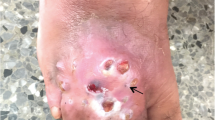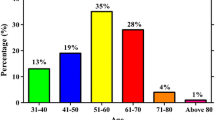Abstract
Fungal infections of foot in patients with diabetes are not uncommon; however, foot infection due to Fusarium species has been rarely reported. We report here a case of a 50-year-old male with type 2 diabetes who developed multiple spontaneous nodular lesions on right foot without any systemic symptoms and signs for 6 months. The lesions were unresponsive to broad-spectrum antibacterial treatment. Fine needle aspiration cytology of nodular lesions revealed the presence of fungal hyphae, and Fusarium species was isolated from the same sample which was identified as Fusarium solani species complex: Fusarium falciforme. Radiological investigations and blood culture ruled out any dissemination of the disease. The lesions healed after voriconazole therapy for 3 months. No relapse was noted at the end of the next 6-month follow-up. All reported cases of Fusarium infection of foot in patients with diabetes in English and non-English literature since 1970 have been reviewed.

Similar content being viewed by others
ReferencesQuery
Chellan G, Shivaprakash S, Karimassery Ramaiyar S, Varma AK, Varma N, Thekkeparambil Sukumaran M, et al. Spectrum and prevalence of fungi infecting deep tissues of lower-limb wounds in patients with type 2 diabetes. J Clin Microbiol. 2010;48:2097–102.
Dogra S, Kumar B, Bhansali A, Chakrabarty A. Epidemiology of onychomycosis in patients with diabetes mellitus in India. Int J Dermatol. 2002;41:647–51.
Nelson PE, Dignani MC, Anaissie EJ. Taxonomy, biology, and clinical aspects of Fusarium species. Clin Microbiol Rev. 1994;7:479–504.
O’Donnell K, Sutton DA, Fothergill A, McCarthy D, Rinaldi MG, Brandt ME, et al. Molecular phylogenetic diversity, multilocus haplotype nomenclature, and in vitro antifungal resistance within the Fusarium solani species complex. J Clin Microbiol. 2008;46:2477–90.
Parvez N, Dutta P, Ray P, Shah VN, Prakash M, Khandelwal N, et al. Microbial profile and utility of soft tissue, pus, and bone cultures in diagnosing diabetic foot infections. Diabetes Technol Ther. 2012;14:669–74.
Heald AH, O’Halloran DJ, Richards K, Webb F, Jenkins S, Hollis S, et al. Fungal infection of the diabetic foot: two distinct syndromes. Diabet Med. 2001;18:567–72.
Bader M, Jafri AK, Krueger T, Kumar V. Fusarium osteomyelitis of the foot in a patient with diabetes mellitus. Scand J Infect Dis. 2003;35:895–6.
Nucci M, Anaissie E. Fusarium infections in immunocompromised patients. Clin Microbiol Rev. 2007;20:695–704.
O’Donnell K, Sutton DA, Rinaldi MG, Sarver BA, Balajee SA, Schroers HJ, et al. Internet-accessible DNA sequence database for identifying fusaria from human and animal infections. J Clin Microbiol. 2010;48:3708–18.
Zhang N, O’Donnell K, Sutton DA, Nalim FA, Summerbell RC, Padhye AA, et al. Members of the Fusarium solani species complex that cause infections in both humans and plants are common in the environment. J Clin Microbiol. 2006;44:2186–90.
Nucci M, Anaissie E. Cutaneous infection by Fusarium species in healthy and immunocompromised hosts: implications for diagnosis and management. Clin Infect Dis. 2002;35:909–20.
Cakir M, Imamoglu S, Cekic O, Bozkurt E, Alagoz N, Oksuz L, et al. An outbreak of early-onset endophthalmitis caused by Fusarium species following cataract surgery. Curr Eye Res. 2009;34:988–95.
Muller C, Schumacher U, Gregor M, Lamprecht G. How immunocompromised are short bowel patients receiving home parenteral nutrition? Apropos a case of disseminated Fusarium oxysporum sepsis. J Parenter Enteral Nutr. 2009;33:717–20.
Garcia-Martos P, Gil de Sola F, Marin P, Garcia-Agudo L, Garcia-Agudo R, Tejuca F, et al. Fungal peritonitis in ambulatory continuous peritoneal dialysis: description of 10 cases. Nefrologia. 2009;29:534–9.
Anandi V, Vishwanathan P, Sasikala S, Rangarajan M, Subramaniyan CS, Chidambaram N. Fusarium solani breast abscess. Indian J Med Microbiol. 2005;23:198–9.
Moschovi M, Trimis G, Anastasopoulos J, Kanariou M, Raftopoulou A, Tzortzatou-Stathopoulou F. Subacute vertebral osteomyelitis in a child with diabetes mellitus associated with Fusarium. Pediatr Int. 2004;46:740–2.
van Dijk E, van den Berg WH, Landwehr AJ. Fusarium solani infection of a hypertensive leg ulcer in a diabetic. Mykosen. 1980;23:603–6.
Torres-Rodriguez JM, Sellart-Altisent M. Bilateral proximal cellulitis and onychomycosis in both big toes due to Fusarium solani. Rev Iberoam Micol. 2006;23:241–4.
Sierra-Hoffman M, Paltiyevich-Gibson S, Carpenter JL, Hurley DL. Fusarium osteomyelitis: case report and review of the literature. Scand J Infect Dis. 2005;37:237–40.
Taj-Aldeen SJ, Gene J, Al Bozom I, Buzina W, Cano JF, Guarro J. Gangrenous necrosis of the diabetic foot caused by Fusarium acutatum. Med Mycol. 2006;44:547–52.
Pereiro M Jr, Abalde MT, Zulaica A, Caeiro JL, Florez A, Peteiro C, et al. Chronic infection due to Fusarium oxysporum mimicking lupus vulgaris: case report and review of cutaneous involvement in fusariosis. Acta Derm Venereol. 2001;81:51–3.
Wu CY, Chen GS, Lan CC. Onychomycosis caused by Fusarium solani in a woman with diabetes. Clin Exp Dermatol. 2009;34:e772–4.
Pai R, Boloor R, Shreevidya K, Shenoy D. Fusarium solani: an emerging fungus in chronic diabetic ulcer. J Lab Physicians. 2010;2:37–9.
Perez-Perez L, Pereiro M Jr, Sanchez-Aquilar D, Toribio J. Ulcerous lesions disclosing cutaneous infection with Fusarium solani. Acta Derm Venereol. 2007;87:422–4.
Garbino J, Uckay I, Rohner P, Lew D, Van Del C, et al. Fusarium peritonitis concomitant to kidney transplantation successfully managed with voriconazole: case report and review of the literature. Transpl Int. 2005;18:613–8.
Girardi M, Glusac EJ, Imaeda S. Subcutaneous Fusarium foot abscess in a renal transplant patient. Cutis. 1999;63:267–70.
Halde C, Padhye AA, Haley LD, Rinaldi MG, Kay D, Leeper R. Acremonium falciforme as a cause of mycetoma in California. Sabouraudia. 1976;14:319–26.
Chen SC, Playford EG, Sorrell TC. Antifungal therapy in invasive fungal infections. Curr Opin Pharmacol. 2010;10:522–30.
Milburn PB, Papayanopulos DM, Pomerantz BM. Mycetoma due to Acremonium falciforme. Int J Dermatol. 1988;27:408–10.
McCormack JG, McIntyre PB, Tilse MH, Ellis DH. Mycetoma associated with Acremonium falciforme infection. Med J Aust. 1987;147(4):187–8.
Negroni R, Lopez Daneri G, Arechavala A, Bianchi MH, Robles AM. Clinical and microbiological study of mycetomas at the Muñiz hospital of Buenos Aires between 1989 and 2004. Rev Argent Microbiol. 2006;38:13–8.
Leu HS, Lee AY, Kuo TT. Recurrence of Fusarium solani abscess formation in an otherwise healthy patient. Infection. 1995;23:303–5.
Acknowledgments
We acknowledge the Indian council of Medical Research for supporting the NCCPF where the molecular identification was done. We are grateful to Department of Photography (Mr. Brij Lal and Mr. Abhijeet) for the taking patient’s photographs. We also thank Mr. Prakamya Gupta, Ms. Shallu, Ms. Pooja, and Mr. Parveen Garg for manuscript editing.
Conflict of interest
None.
Author information
Authors and Affiliations
Corresponding author
Rights and permissions
About this article
Cite this article
Dutta, P., Premkumar, A., Chakrabarti, A. et al. Fusarium falciforme Infection of Foot in a Patient with Type 2 Diabetes Mellitus: A Case Report and Review of the Literature. Mycopathologia 176, 225–232 (2013). https://doi.org/10.1007/s11046-013-9646-z
Received:
Accepted:
Published:
Issue Date:
DOI: https://doi.org/10.1007/s11046-013-9646-z




